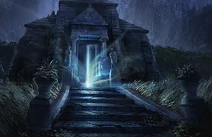Tags: Visual edit apiedit |
(Adding categories) |
||
| (3 intermediate revisions by 2 users not shown) | |||
| Line 33: | Line 33: | ||
The Hȍckwurm subspecies has an electrified epidermis which it uses to scare away potential predators and assist in hunting jellyfish. They generally stay away from humans and more commonly can be seen screwing with the casting lines of German fisherman, and especially Dutch fisherman. |
The Hȍckwurm subspecies has an electrified epidermis which it uses to scare away potential predators and assist in hunting jellyfish. They generally stay away from humans and more commonly can be seen screwing with the casting lines of German fisherman, and especially Dutch fisherman. |
||
| − | Do not mess with any Tatzelwurm, |
+ | '''Do not mess with any Tatzelwurm, it will kill you.''' [[Category:Mythical Being]] |
[[Category:European Mythology, Legend and Folklore]] |
[[Category:European Mythology, Legend and Folklore]] |
||
[[Category:Alpine Mythology, Legend and Folklore]] |
[[Category:Alpine Mythology, Legend and Folklore]] |
||
| Line 46: | Line 46: | ||
[[Category:Feline]] |
[[Category:Feline]] |
||
[[Category:Reptile]] |
[[Category:Reptile]] |
||
| + | [[Category:Germanic Mythology, Legend and Folklore]] |
||
| + | [[Category:Medieval European Mythology, Legend and Folklore]] |
||
| + | [[Category:T]] |
||
Revision as of 17:44, 4 October 2018
Origins
The Tatzelwurm is a creature with origins in Germanic mythology, legend and folklore. The first documented sighting was by Johannes Gutenberg. He was strolling outside the small village Mainz, contemplating the construction of his invention the printing press, when he heard a strange noise. Upon investigating the noise, Johannes discovered a reptilian creature with a feline face. This discovery was the first printed piece.
Appearance
The Tatzelwurm is a scaly, reptilian creature with the head of a feline. The size depends on the availability of food and other environmental factors. They lay eggs. In Southern parts of Germany (Munich), the Tatzelwurm (Stollwurm) blends into its rocky surroundings by possessing a lighter scale color and smaller, wiry frame. It makes its home among the craggy outcrops and in larger recesses that it finds.
Around the forested region of Berlin, the resources available enable it to grow to much larger sizes (Black Bear). Similar to its southern cousins, this subspecies (Praatzelwurm) seeks out natural caves to build its home. Its scales are a darker shade to provide camouflage amidst the trees.
On the coast near Bremerhaven, another subspecies (Hȍckwurm) exists that is semi-aquatic. It creates its home by using washed up kelp along with driftwood. Its main source of food is jellyfish which it catches during leisurely jaunts in the water.

An artist's rendition of the tatzelwurm...
Behavior
The Stollwurm subspecies tends to possess a skittish, non-confrontational nature due to its smaller stature. The Stollwurm travel and hunt in small packs. They are family-based and offspring will usually stay in the family pack well after maturity.
The Praatzelwurm subspecies has an aggressive nature and tends to hunt and live alone, occasionally venturing into villages to consume livestock. The Praatzelwurm only congregate during mating season and leave their offspring only 3 months after their eggs hatch.
The Hȍckwurm subspecies is cunning and cheeky, often getting themselves into trouble and harassing fisherman. They are most akin to otters in their behavior and mate for life.

Abilities
The Stollwurm subspecies are quick and agile in order to quickly traverse their rocky environment. They also have the ability to leap great distances and can often be seen bounding through the air, racing one another. They have sharp, defined backspines which are poisonous. They kill their prey by surrounding it then simultaneously throwing their bodies, back first, towards the prey. They roll around on top until they kill their prey.
The Praatzelwurm subspecies is very large and has a poisonous barb at the end of their tail which is why Johannes Gutenberg didn’t get too close. They also have humongous claws. Their large size and aggression deters everything, even other Praatzelwurms. General scaring/fleeing techniques used when encountering black bears do not work. Waving arms in the air and yelling will only provoke the Praatzelwurm. If it is hungry, there is no escaping one once it sees you.
The Hȍckwurm subspecies has an electrified epidermis which it uses to scare away potential predators and assist in hunting jellyfish. They generally stay away from humans and more commonly can be seen screwing with the casting lines of German fisherman, and especially Dutch fisherman.
Do not mess with any Tatzelwurm, it will kill you.

